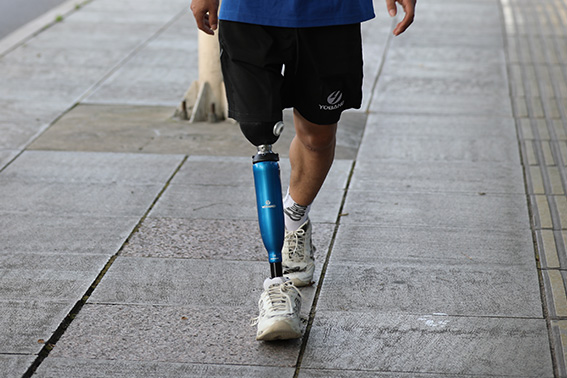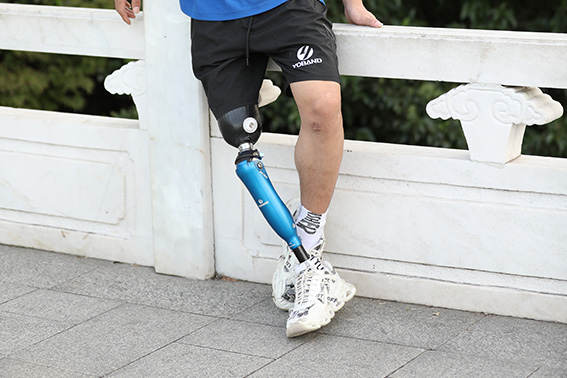News Center |
For patients with AK prostheses, choosing a pneumatic knee or a hydraulic knee has always been a difficult problem. Today, I will tell you about the prosthetic knee.

Whether it is hydraulic or pneumatic, the knee control method is basically the same. When walking, the residual limb drives the prosthetic socket to swing to achieve walking. The prosthetic knee adjusts the damping of the knee according to changes in external conditions to achieve gait adjustment. Because the control method is relatively simple, the realization difficulty is relatively small, and the energy consumption is relatively low, so it is widely used. knee prostheses can be divided into uniaxial prostheses and multiaxial prostheses according to their structures. The uniaxial knee has only a single axis of rotation, and the flexibility is high in the swing phase, but it is not stable enough in the support phase. The multi-axis knee is also called the multi-link knee (generally there are four-link, five-link or six-link, etc.). The design of the multi-link structure can make the rotation center move according to a certain trajectory, simulating the normal walking of the human body. The change of the rotation center of the knee, the rotation axis can be higher than the rotation axis when extending, and quickly drop to the vicinity of the rotation axis when bending, so that it can stretch flexibly, and at the same time, it can maintain the stability of the support phrase. The uniaxial pneumatic knee is suitable for patients with long residual limbs. The four-link pneumatic knee is suitable for many types of residual limbs, and is characterized by being relatively stable.

The pneumatic knee has high flexibility, small motion damping, low requirement for strength, gentle and soft swing, low requirement for temperature, and light weight of gas. The disadvantage is that due to the slightly larger compression rate of air, the accuracy is slightly worse than that of hydraulic pressure.
At present, the multi-axial pneumatic knee is more popular with prosthetic patients. Compared with the uniaxial pneumatic knee, the multi-axial pneumatic knee has better safety, stable practical performance and beautiful walking gait. The damping design that changes with the flexion of the knee enables the patient to walk close to the natural gait and travel safely. Flexible knee flexion and extension, and optimized cylinder control system enable the swing phrase to meet the needs of variable speed and comfortable walking in daily walking, allowing users to walk farther. The natural and harmonious appearance also meets the aesthetic needs of patients.

The multi-axis structure ensures the stability of the support period. The structure of air cylinders and two pistons ensures that the adjustment of buckling damping and extension damping does not interfere with each other. Equipped with a gas compensation device to ensure that the damping is very low in the early stage of the swing, and it is easy to enter the swing phrase. The adjusted damping control ratio in the swing period and the harmonious stretch limit buffer function in the swing period make the gait more natural and reduce the consumption of physical energy. Flexion and extension damping can be adjusted individually. Suitable for young users, middle-aged users and female users with AK amputation, long residual limbs, KD,HD.

The follow-up and gait effects of the hydraulic knee are better, but the price is a bit more expensive than the pneumatic knee, but it is definitely worth the money for patients who usually need to exercise. However, the hydraulic knee also has some disadvantages, because the hydraulic oil is installed in the cylinder of the hydraulic knee, and the performance of the prosthesis will be affected if the weather is too cold. In addition, the placement of the prosthesis also has some effects on the knees. Usually, the prosthesis needs to be erected when not in use, and cannot be placed randomly.

The hydraulic knee has high stability, large motion damping, and small knee swing, which is suitable for young people and patients with a large amount of exercise. No matter how many axes of pneumatic knees, relatively speaking, it is not as good as hydraulic knees. However, good knees are not necessarily suitable, because everyone has different performance requirements for prosthetics. If you are an older person or someone who doesn’t usually exercise much, the installation of hydraulic knees is a bit of a loss. The effect of choosing pneumatic knees is the same, and hydraulic knees are much more expensive than pneumatic knees. It costs a lot of money to install hydraulic knees. But it is similar to cheap pneumatic knees. I believe many patients know how to choose. If it is a young man who usually does some sports, such as running, playing basketball, etc., the effect of the pneumatic kneeis definitely not as good as that of the hydraulic knee.

Therefore, to sum up, from the perspective of relative fit, hydraulic knees are suitable for some prosthetic patients who usually exercise more. The pneumatic knee is more suitable for some patients with less exercise or older patients.
Copyright © 2015 USA-YOBAND. All Rights Reserved 沪ICP备09003269号